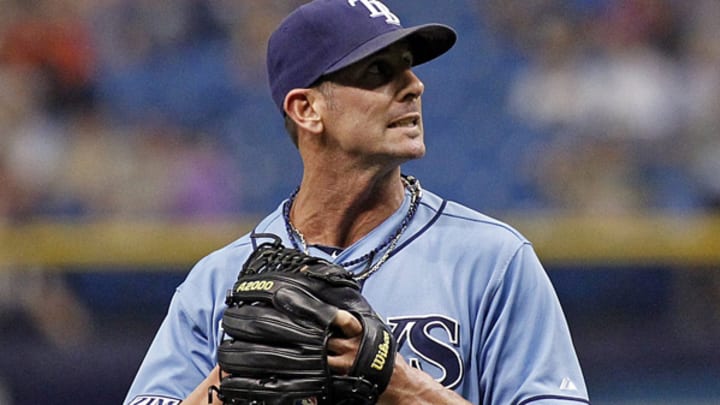Struggles of Grant Balfour, Joe Nathan a reminder that closers are better made than bought

Grant Balfour is out as Tampa Bay's closer after posting a 6.46 ERA this season. (Brian Blanco/Getty Images)

On Monday Rays manager Joe Maddon announced that Grant Balfour, who had given up five runs in the ninth inning of a scoreless game Sunday night, would no longer be his automatic choice to close games. That decision comes less than halfway through the first season of the two-year, $12 million contract Balfour signed with Tampa Bay this past offseason.
In Detroit, meanwhile, Tigers manager Brad Ausmus said yesterday that he's "not even considering" making a similar move regarding his closer, Joe Nathan, though perhaps he should. In his first season with Detroit after signing a two-year deal worth $20 million during the offseason, Nathan leads all closers with four blown saves, has allowed multiple runs in five of his last eight appearances and is sporting a 7.04 ERA.
Add in Jim Johnson, who was acquired by the A's from the Orioles and lost his spot as closer after allowing multiple runs in three of his first five appearances, and three of the five established closers to switch teams this offseason have either lost their jobs or pitched poorly enough to require a public vote of confidence from their manager. The other two -- Arizona's Addison Reed (7.75 K/BB ratio) and Seattle's Fernando Rodney (2.19 ERA) -- are meeting their new teams' expectations.
Expending team resources on established closers remains the greatest inefficiency in baseball, which makes it all the more surprising that the A's and Rays, two frugal franchises famous for exploiting market inefficiencies, were among the teams that did so most recently. Five years ago I wrote that teams were wising up to the fact that "they needn't invest in elite 'proven' closers and [could] easily convert a solid in-house arm or low-cost pickup into a sufficiently reliable closer," pointing out that "a full third of the teams in the majors entered the 2009 season with their closing duties in the hands of a pitcher who had never spent a full season in the role in the major leagues."
This year's crop of intended Opening Day closers was much more experienced. Only the Yankees' David Robertson and the Orioles' Tommy Hunter had never previously served a significant stretch as a team's primary closer. However, far more of this year's established closers are homegrown, team-controlled players. In April 2009, just five of the league's 20 "proven closers" were still in their team-controlled years with the franchise with which they made their major league debut. This April, however, that was true of 11 of the 22 pitchers who opened 2014 as a major league closer. Include Ernesto Frieri -- who debuted with the Padres but recorded his first major league save and 70 more since as an Angel and is in just his first year of arbitration eligibility -- and that number becomes 12 of 22.
That suggests that teams are indeed trending toward, and having success with, making closers rather than acquiring them. To explore this further, I broke those 30 intended Opening Day closers into three groups. The first are pitchers who were established closers when acquired by their current teams. The second group of pitchers were moved into a closer's job by their current teams during their team-controlled years. Third are budget-priced veterans who had limited closing experience when acquired by their current teams but were either brought in to close or ascended to that role soon after joining their new clubs.
Here's how those three groups broke down:
GROUP I: Established closers
Teams: 8 (Athletics, Jim Johnson; Diamondbacks, Addison Reed; Mariners, Fernando Rodney; Nationals, Rafael Soriano; Padres, Huston Street; Phillies, Jonathan Papelbon; Rays, Grant Balfour; Tigers, Joe Nathan)
Changed closer: 2 (A's, Rays)
Save percentage of those players: 87.7 percent
Average 2014 salary of those players: $8.1 million
GROUP II: Created closers
Teams: 14 (Angels, Ernesto Frieri; Blue Jays, Casey Janssen; Braves, Craig Kimbrel; Brewers, Jim Henderson; Cardinals, Trevor Rosenthal; Dodgers, Kenley Jansen; Giants, Sergio Romo; Marlins, Steve Chisek; Mets, Bobby Parnell; Orioles, Tommy Hunter; Reds (Aroldis Chapman), Royals, Greg Holland; Twins, Glen Perkins; Yankees, David Robertson.
Changed closer: 3 (Brewers, Mets, Orioles)
Save percentage of those players: 87.4 percent
Average 2014 salary of those players: $3.9 million
GROUP III: Budget-priced closers
Teams: 8 (Astros, Chad Qualls; Cubs, Jose Veras; Indians, John Axford; Pirates, Jason Grilli; Rangers, Joakim Soria; Red Sox, Koji Uehara; Rockies, Latroy Hawkins; White Sox, Matt Lindstrom
Changed closers: 3 (Cubs, Indians, White Sox)
Save percentage of those players: 84.0 percent
Average 2014 salary of those players: $3.9 million
There are a few things we can see here. First, the league-wide trend is indeed shifting toward finding closers in-house. Second, established closers are no guarantee of reliability. In fact, the guys in Group I haven't been significantly more effective at converting save opportunities this season than the pitchers in Group II (and Group III isn't far behind). Saves are a lousy stat for measuring the effectiveness of a pitcher, but when teams acquire closers, they do so to have them convert save opportunities, and the overall ability of the Group I pitchers above to do that hasn't meaningfully exceed the ability of the Group II pitchers to do the same. The difference between a closer who is made and one who is bought is the pay, not the performance. The pitchers in Group I make more than double the amount of the pitchers in Groups II and III, respectively.
